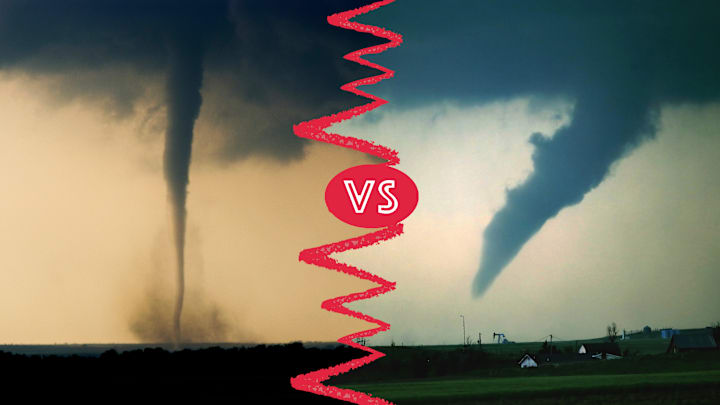If you ever come face-to-face with a whirlwind, the proper name for it will likely be the least of your concerns. The confusion between tornadoes and funnel clouds is widespread, causing people to use the words interchangeably. The mix-up is understandable since they act similarly—but there are key differences between the weather phenomena.
In short, the difference between funnel clouds and tornadoes lies in their positioning.
Funnel clouds are spinning columns of air that don’t touch the ground. All it takes is one intense thunderstorm to cause a funnel cloud. When wind starts blowing at varying speeds and directions, also known as wind shear, the air becomes unstable and a storm begins. Warm air rises while cool air, rain, and hail fall, resulting in rolling currents in the clouds. As the storm brews, it can become vertical while suspended in the air, forming a funnel cloud. These whirlwinds usually precede tornadoes and can dissipate within minutes of appearing; they become tornadoes once they reach the Earth’s surface and wreak havoc.
Of the many forms of natural disasters, tornadoes are among the most destructive. Although most don’t last long and only span a few yards wide, the worst of them can reach wind speeds of more than 250 miles per hour, destroying a pathway that is up to 50 miles long and a mile wide.
Tornadoes occur primarily in North America, with Texas getting the brunt of the natural disaster at an average of 120 yearly. In fact, parts of Texas, Oklahoma, Kansas, South Dakota, Louisiana, Iowa, Nebraska, and Colorado make up what's known as Tornado Alley. The potential for twisters in this area is exceptionally high compared to other parts of the U.S. There, masses of warm, moist air from the Gulf of Mexico, cold, dry air from the Rockies and Canada, and warm, dry air from the Southwest are likely to collide, creating the perfect breeding ground for tornadoes.
Antarctica is the only continent that hasn’t been impacted by twisters. According to the National Centers for Environmental Information, seeing a tornado in the area is unlikely due to the continent’s cold climate and dry air.
Read More Stories About the Weather:
